Table of Contents
Great design starts with the right glow. I’ve gathered pro tips from top designers like Kemble Interiors and Chenault James to help you transform your space. The right setup blends function and style, creating warmth and depth.
Layering is key—ambient, task, and accent lights work together to set the mood. Bulb temperature matters too. Warm tones (2700K-3000K) make areas feel cozy, while dimmers add flexibility.
Whether you rent or own, these strategies adapt to your needs. From sleek pendants to statement chandeliers, lighting reflects your personality. Ready to brighten up? Let’s dive in.
Why Living Room Lighting Ideas Matter
The magic of a well-designed space often begins with thoughtful illumination. Lighting does more than brighten corners—it shapes moods, highlights textures, and even alters how we perceive colors. Poor choices can leave a room feeling flat or harsh, while layered setups create depth and warmth.
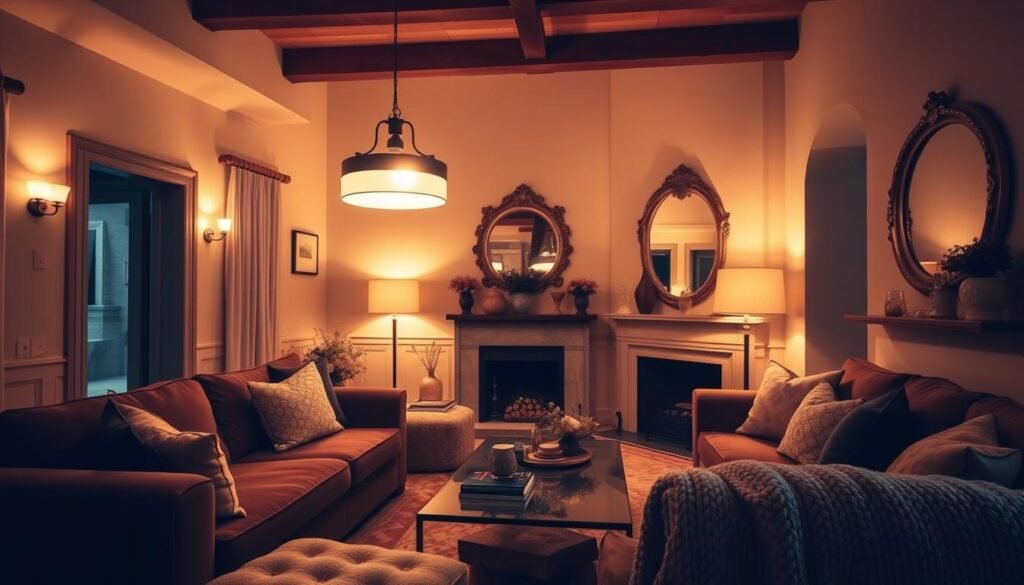
- Practicality meets style: Task lights aid reading, while pendant fixtures add artistic flair.
- Color fidelity: Harsh overhead bulbs can wash out rich wall tones or artwork.
- Psychological comfort: Warm tones (2700K–3000K) promote relaxation, ideal for evenings.
Americans spend 60% of leisure time in their living areas, making lighting zones essential. Dedicate soft sconces for movie nights and brighter LEDs for game days. Mix natural light with adjustable fixtures to match any activity.
Energy-efficient LEDs now offer dimmable options, cutting costs without sacrificing ambiance. Strategically placed lamps can also make small spaces feel larger. In fact, Realtor.com notes that tailored lighting boosts home value by up to 3%—proof that every watt counts.
Focus Light with Picture Sconces
Picture sconces add depth while keeping the focus where it belongs. These wall lights blend function and artistry, turning blank walls into intentional displays. I’ve seen designers like Kemble Interiors use them to spotlight book spines and built-ins—proof that small details make big impacts.
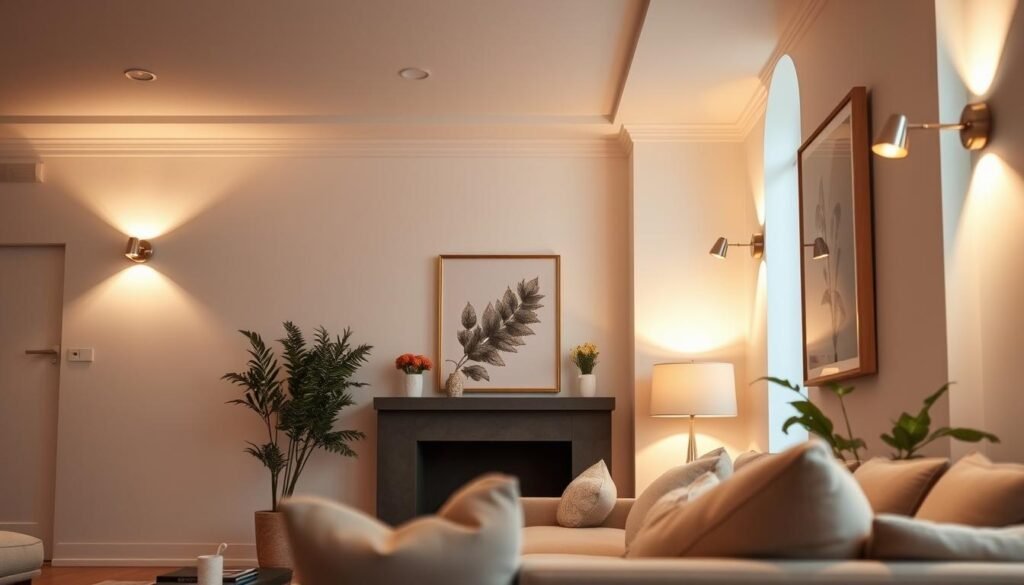
Highlight Built-Ins or Artwork
Position sconces 12–18 inches above shelves or artwork. Angle them at a 30-degree tilt to avoid glare. For valuable pieces, museum-grade illumination (like LED strips with UV filters) preserves colors.
Carmel Brantley’s projects show how directional sconces can frame a focal point. Space multiple fixtures 3–4 feet apart for balanced coverage. Avoid over-lighting—150 lumens per square foot is ideal.
Soft Glow for Ambient Lighting
Dimmable LEDs let you adjust brightness for cozy evenings. Plug-in sconces work for renters, while hardwired options offer a seamless look. Match finishes to your hardware—brass with brass, matte black with iron.
| Type | Pros | Cons |
|---|---|---|
| Hardwired | Clean installation, no visible cords | Requires electrician |
| Plug-In | DIY-friendly, portable | Cords may need hiding |
Bookcases glow when lit from within. Try uplighting sconces behind plants for shadow play. The goal? Accent lighting that feels effortless, not staged.
Embrace Nature with Rustic Fixtures
Rustic fixtures blend raw beauty with modern functionality. They anchor a space with earthy textures while complementing both traditional and contemporary styles. Designer Allison Willson’s tree-branch chandelier in a Toronto home proves how organic shapes become art.
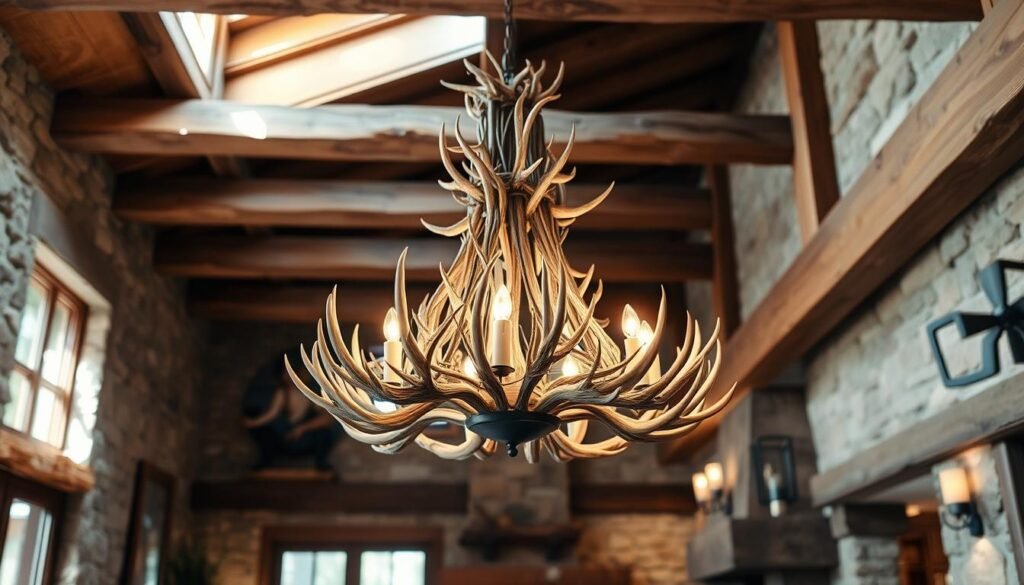
Tree-Branch Designs
These statement pieces work best in rooms with high ceilings. Keep proportions in check—oversized fixtures overwhelm small spaces. Forged iron or reclaimed wood finishes add authenticity.
Materials That Connect Indoors and Out
Trending materials create cohesion:
- Reclaimed wood: Adds warmth and history.
- Rattan: Lightweight yet durable for airy vibes.
- Forged iron: Industrial edge meets rustic charm.
Balance rugged elements with sleek furniture. A linen sofa or jute rug softens the look. For budget-friendly options, try mass-market brands mimicking artisan designs.
Pro tip: Dust textured fixtures with a soft brush. Secure heavy ceiling lights with reinforced mounts—safety first!
Hide Cords Creatively
Tangled wires can ruin aesthetics—here’s how to disguise them beautifully. I’ve tested everything from fabric wraps to wireless tech to keep spaces sleek. The goal? Function that doesn’t sacrifice style.
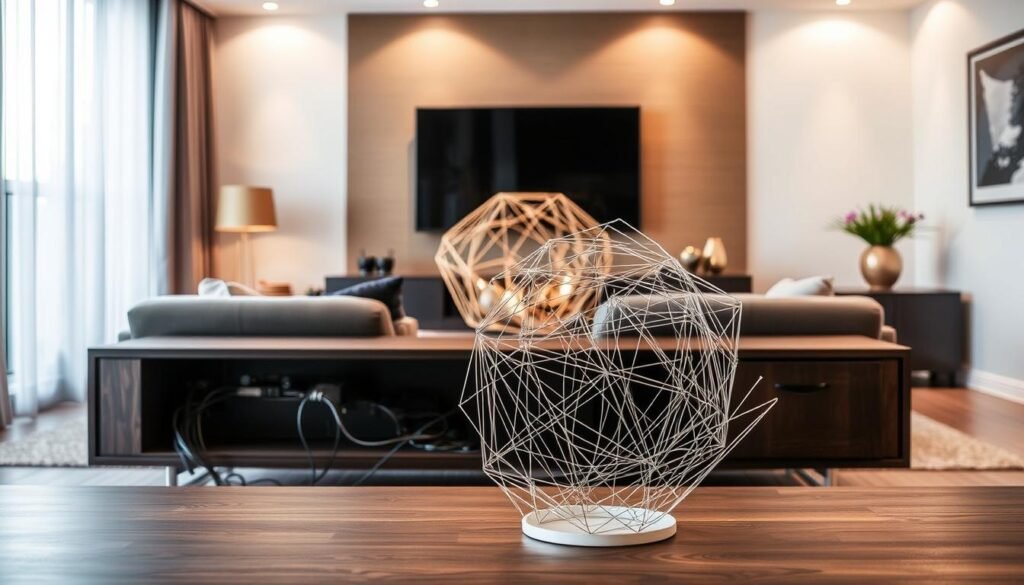
Tassel-Covered Pendant Lights
Cecilia Casagrande’s tassel-covered cords inspired me. Wrap pendant lights with:
- Beaded strands: Thread cords through wooden beads for boho charm.
- Macramé sleeves: DIY with cotton rope for textured appeal.
- Leather wraps: Secure with brass clips for a rustic edge.
Match tassel colors to your decor—navy for coastal themes, terracotta for earthy vibes.
Discreet Wire Management
For a seamless look, try these wire management hacks:
- Cord channels: Paint them to blend into walls (rental-friendly!).
- Furniture placement: Position floor lamps behind sofas or shelves.
- Decorative chains: Swap cords for brass links in industrial spaces.
Pro tip: Avoid fire hazards by keeping cords away from heat sources. Wireless LED strips are a sleek alternative for tight corners.
Color-Coordinate Your Lighting
Designer Colleen Simonds proves chartreuse lampshades can mirror art for instant cohesion. I’ve seen how intentional color coordination transforms spaces from disjointed to curated. Follow these tricks to make your fixtures part of the palette.
Match Lampshades to Your Decor
Use the 60-30-10 rule: 60% dominant (walls), 30% secondary (furniture), 10% accent (lampshades). Translucent shades soften light, while opaque ones amplify bold hues. For renters, vinyl wraps let you swap base colors seasonally.
Repeat Accent Colors Strategically
Pantone’s 2024 trends—like Peach Fuzz—work beautifully in layered lighting. Try these ideas:
- Tonal variations: Pair a sage green pendant with emerald throw pillows.
- Pattern mixing: Striped shades complement floral rugs if colors align.
- Psychological boost: Blue hues promote calm in reading nooks.
Avoid matchy-matchy schemes. Instead, let one fixture echo artwork, like Simonds’ chartreuse example. Rotate shades yearly to keep the look fresh without overhauling decor.
Layer Textures for Depth
Texture transforms flat spaces into tactile experiences—here’s how lighting plays its part. I learned from Wendy Labrum’s projects that plaster walls gain dimension when paired with fixtures that enhance their organic imperfections. The right illumination turns surfaces into storytellers, revealing grooves and grains you’ll want to touch.
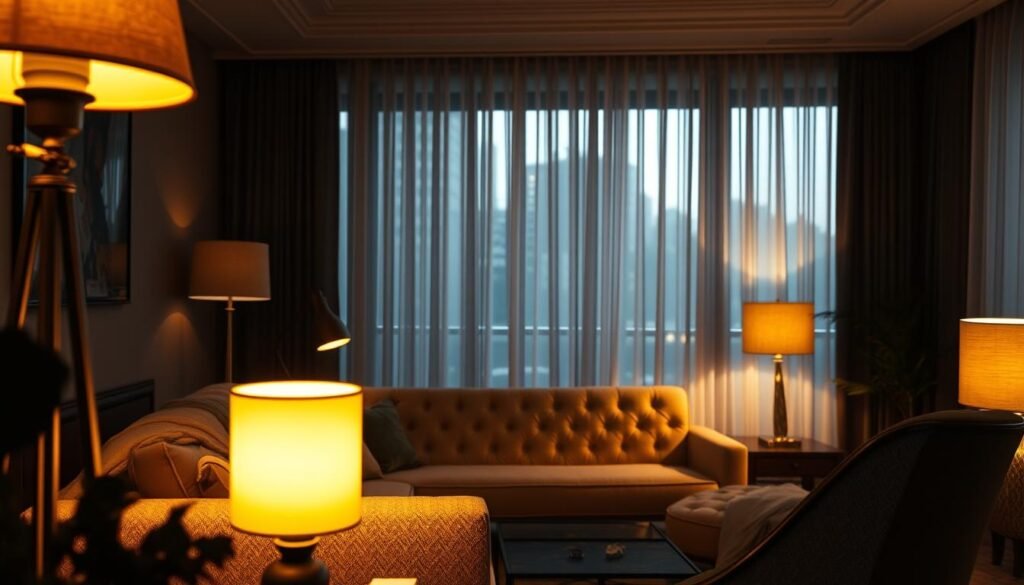
Plaster Walls Meet Tactile Fixtures
Labrum’s signature textured walls work best with matte-finish sconces or hammered metal pendants. The contrast between rough plaster and smooth brass creates visual friction that pulls you in. For renters, try these budget tricks:
- Use joint compound to create faux plaster effects on one accent wall
- Clip-on paper shades mimic the crinkled texture of handmade ceramics
- Position LED strip lights to graze textured surfaces at 45-degree angles
Remember: Overdoing textures in compact spaces feels chaotic. Stick to one statement wall and simpler fixtures elsewhere.
Woven or Metallic Finishes
Current trends favor concrete table bases with brass lamp arms—the ultimate cool-warm balance. Metallic finishes reflect light differently:
| Finish | Light Effect | Best Pairing |
|---|---|---|
| Brushed brass | Soft golden glow | Linen upholstery |
| Polished nickel | Crisp reflections | Glass tabletops |
| Blackened steel | Directional beams | Reclaimed wood |
For maintenance, dust woven rattan with a soft brush weekly. Wipe metallic surfaces with microfiber to prevent smudges. As designer Labrum showed me, depth isn’t just seen—it’s felt through thoughtful material conversations.
Mix Metals for Dynamic Contrast
Metal finishes can transform a space from bland to bold when mixed strategically. I learned this from Kobel + Co’s iconic iron chandeliers paired with bronze lamps—proof that opposites attract. The key lies in balancing warm and cool tones to create depth without chaos.
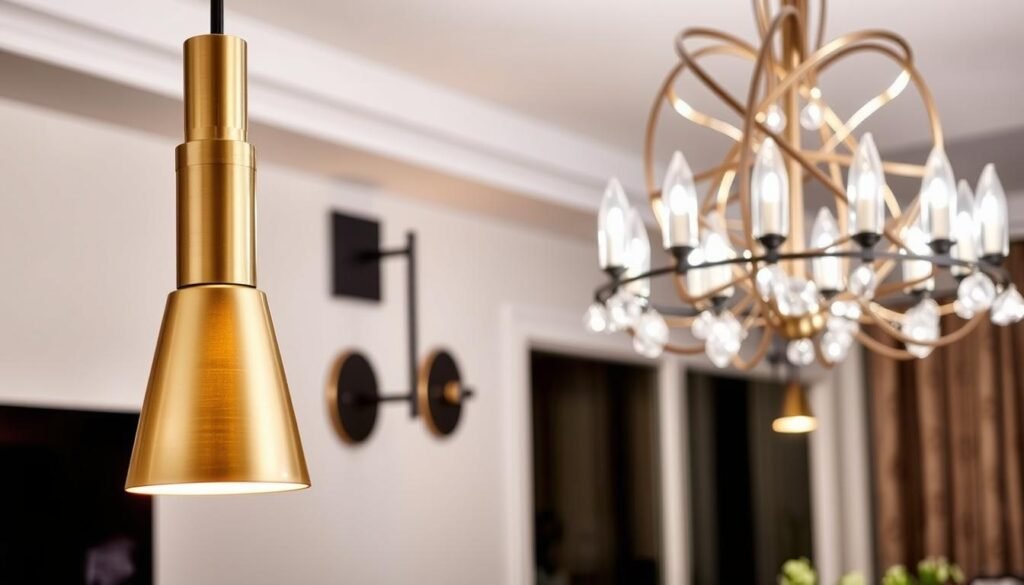
Iron Meets Bronze: A Perfect Pair
Iron’s ruggedness softens when paired with bronze’s warmth. Designer Jenna Kobel spaces these fixtures 4–6 feet apart to let each metal shine. For smaller rooms, use bronze as an accent—think drawer pulls or switch plates—to echo larger iron pieces.
Mastering Metal Ratios
Follow the 70-30 rule: 70% dominant metal (iron), 30% accent (bronze). This prevents visual overload. Unsure? Test combos with paint swatches or sample finishes taped to your walls.
| Metal Pairing | Effect | Best For |
|---|---|---|
| Iron + Brass | Industrial yet refined | Modern farmhouse |
| Bronze + Nickel | Subtle contrast | Transitional spaces |
Pro tip: Let metals age naturally. Bronze develops a rich patina over time—clean it monthly with a microfiber cloth. For quick updates, spray-paint outdated fixtures with metallic finishes.
- Ground with neutrals: White walls or linen textiles prevent clashes.
- Avoid undertone wars: Cool silver and warm gold fight for attention.
- Mix textures: Hammered iron with polished bronze adds dimension.
I once saw a client’s kitchen glow after swapping chrome pendants for mixed-metal alternatives. The contrast elevated everything—even their stainless appliances looked intentional.
Opt for Adjustable Multi-Shade Lamps
Chenault James’ modular designs prove lighting should never be static. Multi-shade lamps combine flexibility with flair, letting you direct light exactly where needed. I’ve used these in home offices and reading nooks—they’re game-changers for task-focused spaces.
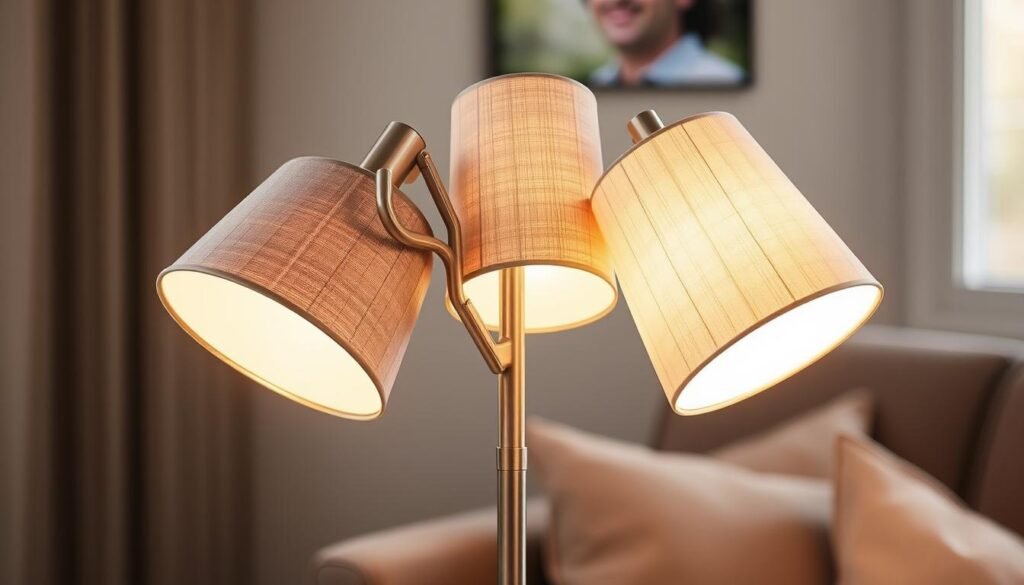
Arc vs. Jointed Arm Designs
Arc lamps sweep over seating areas, ideal for open layouts. Jointed arms offer pinpoint control—perfect for desks. Here’s how they compare:
| Type | Best For | Wattage Tip |
|---|---|---|
| Arc | Ambient illumination | 40W LED (500 lumens) |
| Jointed Arm | Directional tasks | 60W LED (800 lumens) |
Smart Features and Safety
Pair slim-profile lamps with smart bulbs for voice control. Dimmers reduce glare during movie nights. For homes with kids or pets, choose weighted bases or wall-mounted options.
James’ “Have Options” philosophy works: layer a jointed-arm lamp with sconces to create zones. Angle shades 30 degrees away from screens to avoid eye strain. The result? Adjustable lighting that grows with your routine.
Create Intimate Lighting Zones
Transform your evenings with carefully crafted illumination zones. I learned from designer Alex Reid’s plug-in sconces that individual switches let you control ambiance effortlessly. Whether it’s a movie night or deep conversation, layered setups adapt to the moment.
Directional Sconces for Evenings
Reid’s designs prove directional fixtures are game-changers. Install them 5 feet apart to create pools of light where needed most. For reading nooks, aim for 300 lumens—soft but focused.
“Lighting should whisper, not shout. Keep it intimate with layers that respect the space.”
Dimmable Table Lamps
These are my go-to for flexibility. Choose bulbs with a 2700K–3000K range for warmth. Smart plugs let you schedule dimming to align with circadian rhythms—ideal for winding down.
| Zone | Lumen Range | Fixture Type |
|---|---|---|
| Conversation | 200–400 | Floor lamps |
| Task | 500–800 | Adjustable arm lights |
Pro tip: Arrange furniture to guide light flow. A sofa 3 feet from a sconce avoids shadows. For renters, battery-operated options like LED puck lights offer temporary zoning without wiring.
- Map zones: Use painter’s tape to outline areas before installing fixtures.
- Avoid overload: Limit plug-in sconces to two per outlet.
- Romantic presets: Program smart bulbs to 20% brightness after 8 PM.
Light Up Your Living Room with Confidence
You now have the expert tips to transform your home. From Kemble’s layered approach to Kobel + Co’s metal mixing, these strategies create a personalized glow. Start small—one statement fixture can redefine a corner.
Remember, good design evolves. Implement changes gradually, testing bulb temperatures and dimmer settings. ROI isn’t just financial—it’s the comfort of a space that adapts to your day.
Stuck? Consult an electrician for hardwired options or try plug-in sconces for flexibility. Safety first: secure heavy fixtures and avoid overloaded outlets.